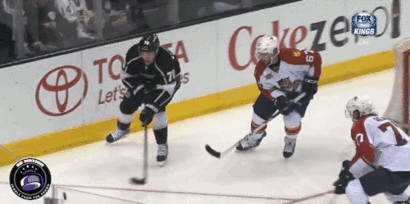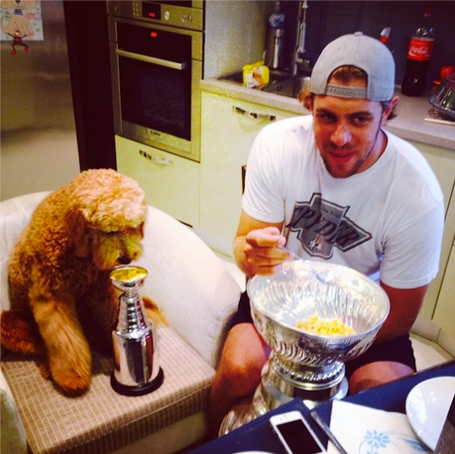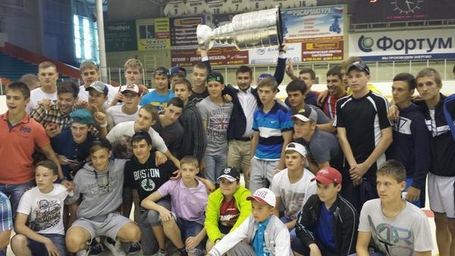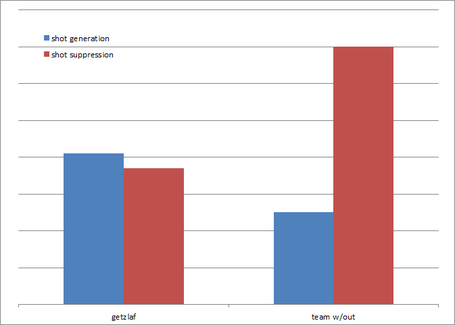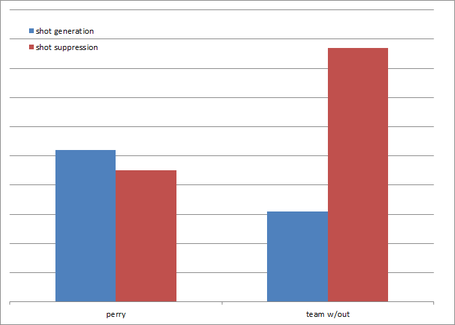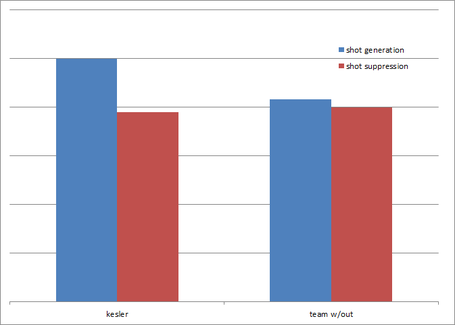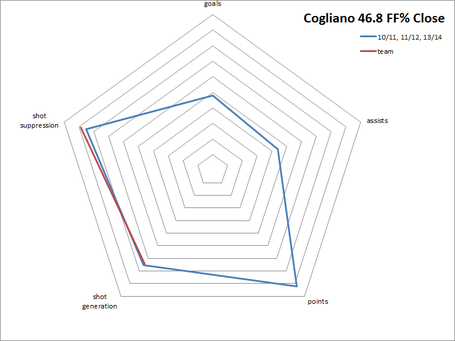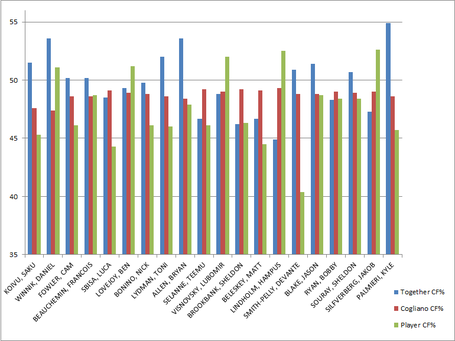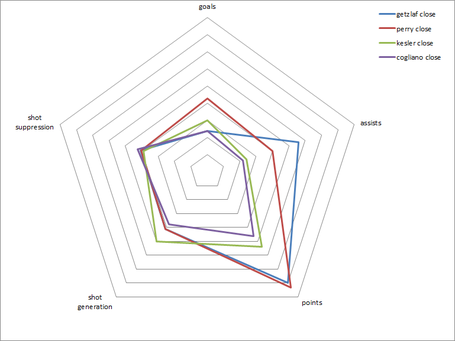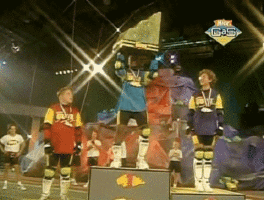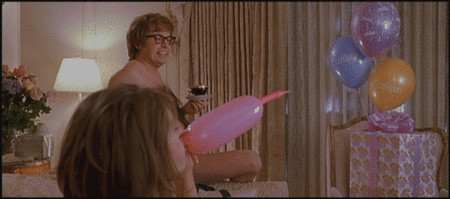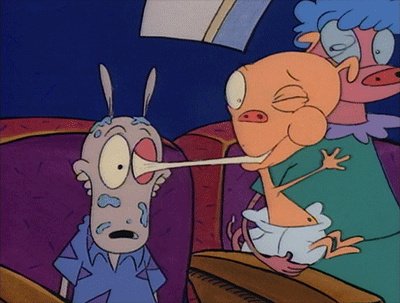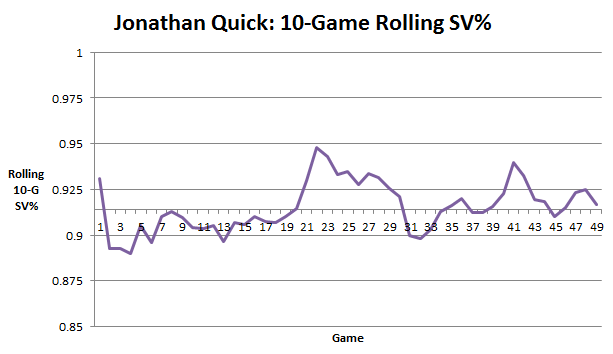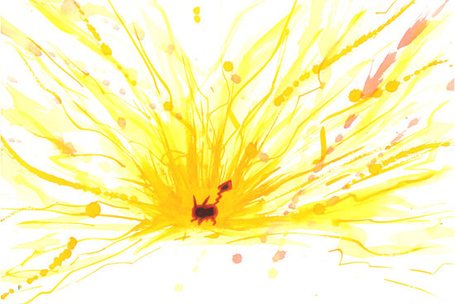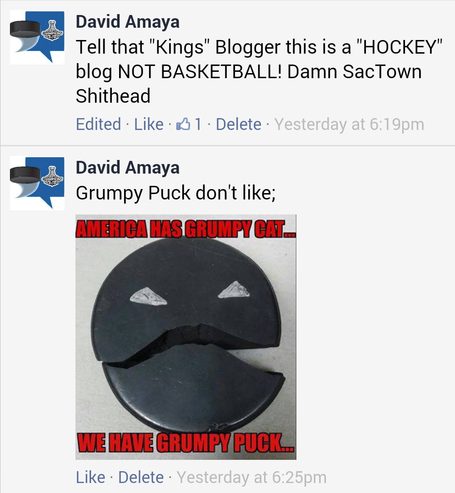![]()
Here's the second part of my look at the Ducks forwards using some nifty charts and stuff.
This is the opposite side of the post I did a bit ago outlining some bottom line forward players (here). We already know what these four players are, with exception to Cogliano, who is potentially coming into himself finally. As such, I'm staying away from things I don't need to show. Getzlaf, Perry, and Kesler are all elite to super elite players in the NHL who make everyone around them better.
Let's get right into the "top three" Anaheim Ducks forwards. I took score close data from the 2010-11, 2011-12, and 2013-14 seasons for each player. I excluded the shortened season because it definitely skewed the numbers (usually higher, which supports them being great but isn't really needed here compared to full season data). For Getzlaf and Perry, I also wanted to grab enough of an impression of time with Carlyle.
Once again, to create an "impressions" visual I removed any scale from the trend chart here. I find this works better when comparing ranges of players, personally. What I want to highlight with each player is both what he adds production-wise but also what he contributes to shot generation and suppression, or offense and defense very loosely. In Getzlaf's case, we see a confirmation of what we've really come to know from him.
![Getz_web_medium]()
Getzlaf is not a pure finisher. He has a hard shot but not necessarily one that's overly accurate. Again, this is beyond what's average for most guys in the league but is merely average for an elite player. When I see this trend chart, I can understand a bit more why fans and coaches have wanted Getzlaf to shoot more, and why he doesn't. It isn't his strength.
By the numbers, Boudreau hasn't gotten Getzlaf to shoot more either. What it appears he's done is convince him to go to the net more, which is more in keeping with what the centerman's strengths are: puck handling and vision. Under Carlyle's more "safe," passive systems, Getzlaf likely didn't charge the net as much himself because his coach wanted him to be in position to defend. Boudreau has allowed his big horse to run, and it has resulted in Getzlaf's best production in his career.
His shooting percentage suggests he was a bit lucky to achieve that in 2013-14, but the types of looks he ended up putting on net were generally better "quality" shots. (Stats people hate that, but the quality of shot, while not as predictive as possession metrics, does sometimes apply toward the scoring outcome of games.) Getzlaf is more or less a volume shooter, but under Boudreau he has held onto the puck longer, which is likely his preference, and went around more defenders. This allowed him to produce more from the same approximate rate of shots.
To better show the relationship between Getzlaf's offensive and defensive contributions (generation and suppression) versus his team without him on the ice, I took the same numbers from the previous trend chart and put them here, sorta zoomed in. This makes it look more extreme but that's because I pulled it up closer, as it were.
![Getz_shots_medium]()
This is Getzlaf's unblocked shots for per 20 minutes on average as well as the shots he's faced per 20 minutes. Or: every 20 minutes of play, this is what Getzlaf does offensively and defensively. The right columns are what the Ducks do without him on the ice per 20 minutes. As you can see, the team is awful without him (in score close situations).
Perry is basically a shooter with a power forward's makeup. Here's his chart.
![Perry_web_medium]()
Notice how his rate of generation is more or less in line with the goals he's produced. (This is true for most of his career as well, not just the years sampled here.) That tells me he's got a very good finishing ability, which is only made better because he's getting pucks in his preferred spots from Getzlaf. On the recent Anaheim Calling podcast, there was a conversation about the best one-two duos in Ducks history. This is one of those things that make a strong argument for Getzlaf-Perry as my number one: they are two of the most complementary players I've ever seen together visually, stylistically, and statistically.
I didn't mention this in Getzlaf's charts, but part of why I dropped the lockout season (aside from inflated numbers for the sample) is because I really wanted to see a more or less even split of numbers from Carlyle's Ducks and Boudreau's Ducks. Unlike Getzlaf, who has benefited much more from a coach like Boudreau, Perry has basically stayed the same player.
If I were to guess, I'd say this is because Perry would be who he is no matter who coached him or who he played with, and what team or situation he was on/in. Perhaps due to his position as a winger, he's one of the most even players I've ever tracked numerically, regardless of everything. Perry is consistently excellent at hockey and at being an asshole that other fanbases hate.
Like Getzlaf's breakdown of offense and defense, here's Perry's chart.
![Perry_shots_medium]()
They are nearly identical, which makes sense because they play so much in score close together. Also, peer into the depths of what the Ducks are without Getzlaf-Perry and tell me they are more than a one-line team when games matter.
So here we are, faced with Anaheim having a true second line center for the first time in years. What do his numbers look like with the same trends/offense-defense charts I've run Getzlaf and Perry under? Without further ado, here's his chart.
![Kesler_web_medium]()
Huh. Kesler is an absolute offensive powerhouse. What he lacks in outright production, likely due to playing center and being similar to Getzlaf in finishing ability (average for a top line player), he more than makes up for in creating unblocked shots. That's very impressive. And this is with two different coaches, similar to the Carlyle/Boudreau switch the Ducks had, but in reverse: the better coach was there for the first two years. Even under the "worse coach" in the last year, Kesler did great in generating shots.
As a quick aside, this seems to be what good second line players are league-wide. They frequently produce less than top line guys but they tend to create as much if not more offense in terms of shot share. I've begun keeping a smallish database of players I've seen this trend for, guys who produce less than they should up next to the possession numbers they have. By and large, they are the really good third liners or second liners on good teams. I think this sort of broader trend is worth keeping an eye on for sure.
Here's Kesler's offense and defense up close against his former team's numbers.
![Kesler_shots_medium]()
Obviously, the Vancouver Canucks were a much better team without Kesler than the Ducks are without their top two. That being said, Kesler still generated more and gave up less when he was on the ice despite team strength. This bodes well for Anaheim. While he might never put up the offensive production of his past, Kesler should help solidify another top unit for the Ducks. Given what this team is without the top two on the ice, every little bit will help.
These are the Ducks' top one-two-three forward players. Now I am going to include the distant fourth best forward on the team. I make that statement pretty definitively, because toward the end of last season he was great. In the playoffs, he was outstanding.
Cogliano is an interesting inclusion to any list of "top players" of course. A first round pick by the Edmonton Oilers, he played center for them until eventually landing in Anaheim, where he was converted to a winger. When he first entered the league, he put up ok numbers for a young guy. But that was his peak performance, which is troubling for a player expected to improve. He achieved nearly the same success last season as his first in the league, so there's some hope here. He also did so despite playing nearly every minute with the ruined Saku Koivu.
If that doesn't sound like an inspiring tale for a guy I'm about to declare is the fourth best forward on the Ducks roster right now, I agree. It really doesn't. But Cogliano put together a pretty sneaky good playoff. He wasn't dominant by any measure, but was a positive possession player in more than half the Ducks games, including seven performances wherein he was positive relative to his teammates as well. This is impressive considering the Ducks played two superior possession teams in the Dallas Stars and Los Angeles Kings as well as his constant pairing with the aforementioned Koivu.
Yet Cogliano is a curious case of a secondary player who can succeed with the right pairing, as his numbers in Anaheim suggest. But first, here's his trend chart. Note of course that in 2010-11, he was with the Oilers, who were very bad at hockey that season.
![Cogs_web_medium]()
He's pretty similar to some of the trends I showed in the previous post about bottom of the lineup players. His generation to suppression rate looks about similar to the team trends for both the Oilers and Ducks during the range of years shown. The differences between Cogliano and team performance without him on the ice aren't significant enough to zoom in on, but it should be noted that Cogliano generated slightly more shots than his team without him.
But nothing yet really supports my argument that he's the fourth best forward in Anaheim until you look at his with-or-without-you possession numbers. For the sake of keeping this relatable to this team, I removed his Oilers teammates and added back in the lockout-shortened season to balance minutes lost.
![Cogs_wowys_medium]()
Cogliano together with almost every player is better than his individual numbers. In some instances, his pairings upped both players' possession rates significantly. Koivu was lost without him. He and Daniel Winnik were grand together. Both Cam Fowler and Francois Beauchemin benefited from his being out there with them. Even Bryan Allen had good numbers with Cogliano.
What's this mean though? Notice the lack of Getzlaf or Perry in the top players he's seen minutes with on the Ducks. All of the gains on the chart are largely achieved without the elite of this roster, telling me that in Cogliano the Ducks have a decent complementary winger who tends to support the breakout better than most wingers on the team. (I derive this from what I've watched and from the way he's boosted all his defensemen's numbers pretty evenly.)
The real flaw in Cogliano's game then is his inability to contribute heavily toward offense (generation) by himself, as his defensive play tends to suggest he can turn play through the middle just fine. Some of this is his consistent pairing on two-way lines in Anaheim, but I also think it's just one of the things he does poorly. He's not a shooter by any stretch. But give him the puck and he can support it into the zone, where a shooter could theoretically make some noise.
This is exactly why I think a pairing of Kesler and Cogliano will serve the Ducks well on a second line. Kesler generates offense. Cogliano props up possession and supports breakouts well. This could be a line that gets the puck, sends it through the neutral zone quickly, and gets it toward the opposing net fast. Add in a shooter to the line, particularly of the volume variety, and suddenly two players who aren't expected to post a lot of production could luck out for a year or two.
You know who shoots the puck a lot from the left side but needs two healthy linemates to get the puck to him in the offensive zone? Dany Heatley. Could he be a sometimes fit on that left side for Kesler and Cogliano? It's a thought. If Boudreau wants someone with more speed to go on that line, Cogliano could slide to the left side to make space for Kyle Palmieri as well. Not to mention that the team would probably like Palmieri to shoot more anyway. Add in Patrick Maroon and Jakob Silfverberg as left side players who will likely see time on Kesler's line, and suddenly Cogliano's importance as a stabilizing agent on the right side of that second line stands out a bit more in the options the team has next year.
At least I think so.
And finally to put a bow on the whole thing, here's the pretty "everyone" chart.
![All_t4_web_medium]()



.jpg)



